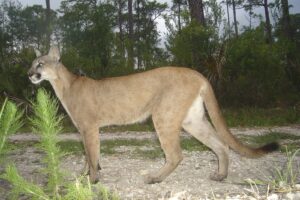Genetic Rescue
Genetic rescue is a strategy aimed at improving the genetic diversity and fitness of a small, inbred population by introducing individuals from another population. This process helps to reduce inbreeding depression and increase the population’s adaptability and resilience to environmental changes. By enhancing genetic variability, genetic rescue can prevent the extinction of endangered species and support their long-term survival.
Outbreeding
populations or genetically distinct groups to enhance genetic diversity. In the context of endangered species conservation, this strategy is used as a genetic rescue technique to mitigate the negative effects of inbreeding depression and to increase the genetic health of small populations.
Benefits of Outbreeding for Genetic Rescue:
- Increased Genetic Diversity:
Introducing new genetic material can replenish the genetic diversity lost through inbreeding and genetic drift. This diversity can enhance the overall adaptability and resilience of the population to environmental changes and disease. - Reduction of Inbreeding Depression:
By introducing alleles from an unrelated population, the prevalence of harmful recessive alleles can be diluted, reducing the expression of genetic disorders and increasing fitness. - Improved Reproductive Success and Viability:
Increased genetic diversity often leads to improved fertility rates, higher survival rates among offspring, and a more robust immune system. This can enhance the long-term viability of the endangered population. - Enhanced Evolutionary Potential:
A genetically diverse population is better equipped to respond to environmental changes and challenges, which is crucial for species recovery and adaptation in a changing climate.
Problems and Risks of Outbreeding:
- Outbreeding Depression:
While outbreeding can improve genetic diversity, it can also result in outbreeding depression. This occurs when two distinct populations have evolved different local adaptations, and their hybrid offspring lack the specialized traits needed to survive in either parent’s environment. Hybrid offspring may exhibit reduced fitness due to the breakdown of coadapted gene complexes. - Genetic Swamping:
Introducing new genetic material can overwhelm the local genetic structure, erasing unique local adaptations and homogenizing populations. This may threaten the survival of endemic traits critical for the species’ adaptation to specific ecological niches. - Behavioral and Social Disruption:
Mixing individuals from different populations can lead to conflicts due to differences in mating systems, social structures, or behaviors, affecting reproduction and social cohesion. - Disease Transmission:
Movement of individuals between populations risks introducing new pathogens to a naïve population, potentially causing disease outbreaks that can further threaten the endangered species.

De-extinction Initiatives
De-extinction technology, the process of reviving extinct species, has gained increasing attention in recent years as a potential tool for genetic rescue. While this concept has been popularized through speculative fiction, significant scientific advancements are turning de-extinction into a tangible, albeit challenging, possibility. The objective of using de-extinction as a genetic rescue strategy is to enhance biodiversity and restore lost genetic traits to current ecosystems.
There are three primary methods through which de-extinction might be achieved: back-breeding, cloning, and genetic engineering. Each has its potential benefits and limitations.
Back-breeding involves selectively breeding closely related extant species to recreate the phenotypes and traits of the extinct species. For instance, by choosing individuals that possess particular ancestral characteristics, conservationists can emphasize these traits through generations of breeding. One prominent example is the attempt to recreate the Aurochs, an extinct wild cattle species. Scientists have selectively bred modern cattle breeds to produce a genetically similar animal that mimics the appearance and behaviors of the original.
Cloning is the process of creating genetically identical copies of an organism by using preserved cells of the extinct species. In cloning, scientists take a nucleus from a cell of the extinct species and insert it into an egg cell of a closely related living species that has had its nucleus removed. The egg is then stimulated to develop into an embryo and implanted into a surrogate mother. However, cloning is technically challenging due to the availability and preservation quality of ancient DNA. Moreover, cloning often faces ethical concerns and low success rates in developing healthy offspring.
Genetic Engineering represents the most cutting-edge approach, leveraging CRISPR/Cas9 gene-editing technology to modify the DNA of a closely related living species. By comparing the genomes of extinct and living species, scientists can identify genetic differences responsible for specific traits. The genome of the living species is then altered to reflect the extinct species’ traits. An example includes the project to bring back the woolly mammoth by editing the genome of Asian elephants. The goal is to produce elephants with traits adapted to colder climates, akin to the extinct mammoths.
While de-extinction is theoretically feasible, its practical application as a means of genetic rescue remains contentious. Proponents argue that de-extinction can restore lost ecological functions and enhance genetic diversity, particularly for closely related endangered species. For instance, reviving the passenger pigeon could re-establish its role in maintaining forest dynamics in North America. However, critics point out the high costs involved and the potential ecological risks of releasing genetically modified or resurrected species into modern ecosystems. Moreover, focusing on de-extinction could divert resources away from protecting existing endangered species that still require urgent attention. The ethical implications are also significant, raising questions about humanity’s role in shaping nature. How do we decide which species should be resurrected, and how will their reintroduction affect current ecosystems? Furthermore, even if an extinct species were successfully revived, it would face significant challenges in adapting to current environmental conditions, which are vastly different from those in which it evolved.
Despite these challenges, de-extinction remains a fascinating frontier. It exemplifies the innovative thinking required to address the current biodiversity crisis and offers a new perspective on humanity’s relationship with nature. Scientists and policymakers will need to carefully balance the technological potential with ethical and ecological considerations to determine the role that de-extinction should play in future conservation strategies.
Media Attributions
- floridapanther2 © Larry W. Richardson/USFWS is licensed under a CC BY (Attribution) license

